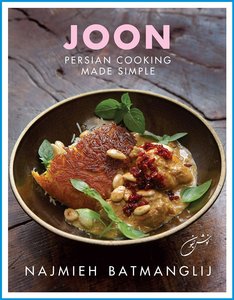Joon: Persian Cooking Made Simple by Najmieh Batmanglij
English | 6 Oct. 2015 | ISBN: 1933823720 | 224 Pages | AZW4/PDF (True) | 62 MB
English | 6 Oct. 2015 | ISBN: 1933823720 | 224 Pages | AZW4/PDF (True) | 62 MB
In Joon, master chef Najmieh Batmanglij distills one of the world’s oldest and most influential cuisines to capture its unique flavors in recipes adapted to suit our busy lives. Najmieh’s fans have been making meals from her Food of Life for more than 30 years. For Joon she has simplified 75 of her favorite dishes and shows how, with the right ingredients and a few basic tools and techniques, authentic Persian food can easily be prepared at home.
Joon means “life” in Persian. It can be used in multiple ways, from a term of endearment akin to “darling” after someone’s name to showing great enthusiasm: “I love it!” The expression nush-e joon, literally “food of life,” is similar to the French “bon appétit,” a wish that a meal will be enjoyed.
Iran and Persia refer to the same place. These days we use “Iran” to refer to the country and “Persia” or “Persian” for the culture, from Persian carpets, and Persian cats to, Persian cooking. Persian, also called farsi, is the language of Iran.
Iran is situated at the center of the ancient network of trading routes—known today as the Silk Road—that connected China in the east to Italy in the west. The royal kitchens of two ancient Persian empires, a thousand years apart, were famous for their cooking, which both influenced and was influenced by the cuisine of countries along the Silk Road. Later, in the ninth century, it was the Arabs of the Abbasid court in Baghdad who spread Persian culture and cooking more widely in Europe and North Africa.
Much of Iran’s cuisine is essentially vegetarian. Although kababs are popular restaurant fare, they represent only a small sampling of the dishes Iranians eat at home. Persian cooking, with its emphasis on fresh, natural ingredients corresponds with the trend in eating that’s spreading across America. “Join the delicious revolution!” as Alice Waters says; “Eat simply, eat together, eat seasonally, shop at farmers markets.”
The recipes in this book—each accompanied by a photograph of the finished dish—come straight from Najmieh’s kitchen and include not only the classics of Persian cooking, but also some soon-to-be favorites, such as quinoa or kale cooked Persian-style. You’ll discover delicious side dishes, from cooling, yogurt-based salads and tasty dips and spreads, to more sustaining platters of grains, beans and fresh herbs; tasty “kukus”—frittata-style omelets filled with vegetables and herbs; spice-infused fish; mouth-watering meatballs and kababs served on flat breads with tangy sauces; every kind of rice—including the incomparable polow topped with various sweet and sour braises; not to mention, delightfully aromatic cakes and cookies to round off meals or enjoy as a snack in between.



